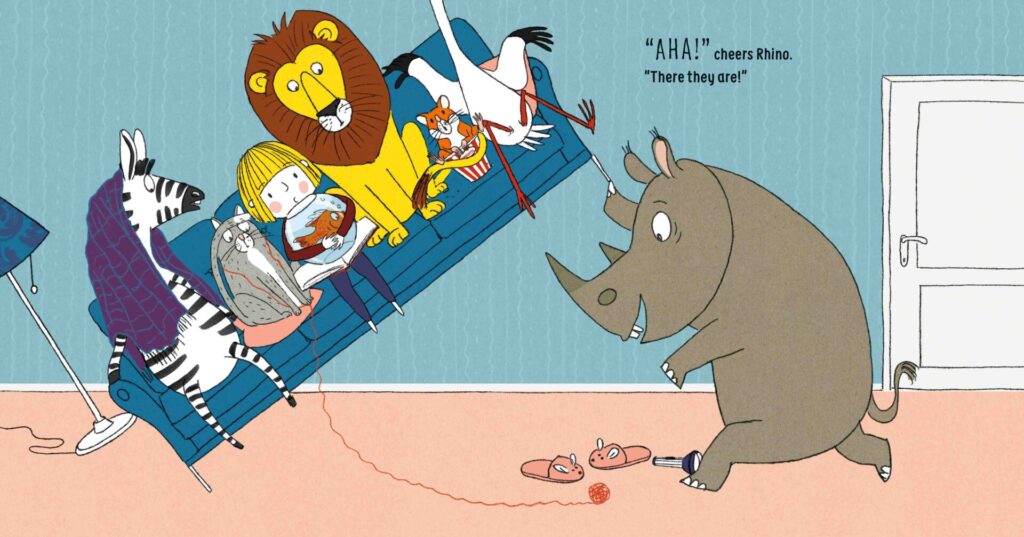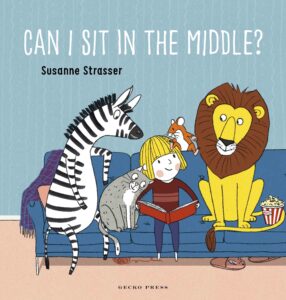 Susanne Strasser studied communication design and illustration in Munich and London. She is the author and illustrator of many successful picture books, including this bestselling series of board books about animal friends. She lives with her family in Munich.
Susanne Strasser studied communication design and illustration in Munich and London. She is the author and illustrator of many successful picture books, including this bestselling series of board books about animal friends. She lives with her family in Munich.
How are your stories born? Where do they start?
The creative process is not that exciting. It’s a lot of thinking, fighting against doubts, fighting the “fear of the white paper.” I usually start writing first (on my PC) and then do quick sketches by hand with pencil to see if the things I have in mind can work visually. Sometimes it’s the other way around and my starting point is an image. Usually writing, sketching, thinking all go hand in hand; it is a fluent process
What is behind the story of Can I Sit in the Middle?
Only my own experience as a mother. Before bedtime, me and my two kids used to read on the sofa but, as in the book, it wasn’t always that easy. There was always something missing…one child had to go to the toilet, the other needed a cuddly toy, one asked for something to drink, then the other for a different book, one wanted to sit on the left side, the other closer to the lamp…a thousand “issues” before we could finally get started. This story is taken from a central part of our family life and is just pure life experience.

What is the importance of the structure and refrain in your books?
Like all my books in this “series,” the story has a cumulative structure that builds to a twist and an unexpected happy ending. This structure automatically creates expectations and growing excitement. I think most parents or educators in kindergarten are very familiar with this “getting ready” to read aloud together.
In Can I Sit in the Middle?, the child and animals come together to read a book but, every time they want to start, something disturbs the cozy setting. This delay of the reading pleasure, the “waiting for,” is emphasized by the almost mantra-like repetition of the text. And the interruptions in the story are reflected in the text by leaving out the important word “book” that only appears at the very end when they finally get started.
How do children respond to this book?
Children (and adults) like the familiar setting, the cozy reading on a sofa. Almost every child knows this, whether from home or kindergarten. And when they hold the book in their hands, they almost slip into the role of the child on the cover. The listeners automatically add the missing word “book” when the book is read aloud, which adds playful interaction between the adult reader and the child.
Children also like the cute animal characters and their fun expressions and that every animal has its own little side-storyline that is not mentioned in the text. It is fun to discover that.
What do you think gives your board books their special appeal to children?
My books are characterized by cumulative and repetitive patterns, which are especially appealing to small children: soon the children know the text by heart and can “read” the book by themselves as if they were proper readers. They quickly learn how the structure works: the story is predictable till a certain point, which gives the children confidence and safeness, knowing what comes next, and also some growing excitement that soon something fun and not predictable happens: a turning point that will bring a happy ending!
I like developing proper stories for this young age, when kids discover the wonder of language, how words and things sound. This works brilliantly with cumulative and repetitive patterns. Children at this age especially enjoy the onomatopoeic language, which is fun to read, hear and repeat.
Humor plays a very important part in my work. I try to create little stories that are funny, with funny characters and, most importantly, taken from their everyday life. Humor is very human, and even small children understand it very early. And humor is a great narrative tool to entertain.

How is the experience of having books translated for you?
I am very happy that my books are translated into so many different languages. It’s almost unbelivable for me that children all over the world can read my books, and I’m very grateful. I receive many nice messages from families through social media, photos or even videos of their kids reading my books. This is very touching. It’s always exciting to hold a copy of my book in a foreign language in my hands.
How do you create the artwork for the books?
First I write, then I draw a little rough storyboard to see if it the story works in pictures. I do a lot of sketches of the animal characters, from very detailed and realistic to a simplified, almost two- dimensional appearance, as I want them in my books.
Then I prepare monoprints—the black and grainy outlines in my illustrations are not pencil drawings but handprinted monoprints. With monoprinting, you spread thick ink onto a glass plate, then carefully put a piece of paper on top of the ink plate and draw with a pencil or biro onto the paper. The ink from the plate transfers onto the other side of the paper.
I then have all these black and white prints (around 60 A4 sheets per book) scanned and put them together as spreads digitally, then color them in Photoshop.









What are books for you? And why do children need them?
I see myself as a storyteller. I want to tell something either in words or with an image. Drawing and writing is a way to understand the world, to get to know it and convey it to others. So books are a way to express myself.
As a reader, books give me a chance to reflect, a doorway to imagination, a little escape from everyday life—actually pretty much the same as for children.
Books are a great magic treasure box! They allow children to dream, to think the impossible, to dive into imagination, to escape ordinary life and put on different roles. Which again prepares for reality. Last but not least books can be a way of entertainment and having fun! Books for children should be a pleasure.
Can I Sit in the Middle? | Available from all good bookstores
This read-together board book is a snowballing narrative of animal chaos that culminates in
story time under a blanket tent.


